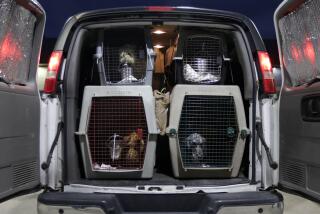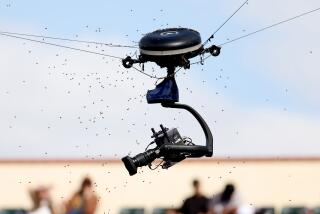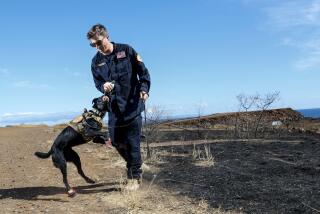Termite Inspector’s Work Going to the Dogs as Business Grows
- Share via
BELMONT, Calif. — Most people doubtless have heard tales of bloodhounds tracking lost children through dark and forbidding forests. More recently, photos have shown dogs sniffing out smuggled marijuana in airport luggage or nosing about packages searching for bombs.
Now, here comes Robert Outman and his termite-sniffing beagles.
Outman runs a training school in this San Francisco suburb teaching beagles to smell and listen for live wood-destroying insects in places inaccessible to the naked human eye, much like their bomb- and drug-sniffing cousins.
Together he and his beagles have added a new dimension to the insect inspection business throughout the country. Outman, owner of TADD Services Corp. here, launched his business after he bought a house in 1977 that had been declared termite-free.
He soon discovered the contrary.
“In my case I bought myself a lovely bunch of termites,” he said.
He admits that he neglected to read the fine print on the inspection document that states that the inspector is not liable for areas of the property inaccessible to sight inspection, such as inside walls and underneath carpets. But it still angered him that termites could do so much damage--about $1.17 billion worth a year in the United States--and that many homeowners don’t discover it until their walls resemble shredded wheat.
The former San Mateo County sheriff’s deputy--sidelined from duty by a gunshot wound--had previously won several awards for training narcotic- and bomb-sniffing canines. It only seemed logical that he could train animals to detect termites.
Having already earned a stack of animal behavior and training certificates, he set out to learn all he could about entomology--the study of insects. At one point, he considered training aardvarks or anteaters to track down the insects, but settled on the male beagle because it ranked first in scent and hearing tests.
Dogs Leased
Now seven years in the business, TADD--which stands for Termite-Ant Detection Dog--leases 50 dogs to various pest-control companies in the United States.
A typical inspection goes like this: The beagle trots out of his custom van (complete with the dog’s name and photograph on the side) and the trainer slips a red collar around its neck. They enter the premises to be inspected and the beagle follows his handler, sniffing and listening along walls, under couches, in attics. If he smells or hears any termite activity, he begins a digging motion.
“Come on, dig ‘em out. Atta boy, dig, dig,” the trainer encourages.
The human exterminator then knows exactly where to spray, or a carpenter can replace the infested area.
The termite-inspecting dog service is the only one of its kind in the United States. Out of 15,000 inspections, only one claim of undiscovered termites has been filed against TADD, Outman said.
For skeptics, Outman cites an Ohio State University study that endorsed the termite-finding ability of TADD dogs as well as testimonials from customers and entomologists who have praised the service. All have reached the same conclusion: It has to be seen to be believed.
No Complaints
Mark Thyne, an exterminator with Terminix in Brookline, Mass., said in a telephone interview that he has not had one complaint in the 18 months that a TADD dog has been sniffing for him. Thyne, like all other TADD dog handlers, went through a long screening process before his dog, Stewart, was leased to him.
In Tucson, attorney Richard S. Oseran called in a TADD dog when purchasing a $200,000 home in 1984. Oseran said he was convinced of the dog’s expertise when he and a carpenter followed the four-legged inspector around the house and dug into the wood with a saw in the areas the dog indicated had termites. They found termites.
It costs the customer about $125 to $250 for an inspection, depending on the size of the building.
An inspection is potentially dangerous if the floors have been weakened by termite-infestation, and the dogs are personally insured for $25,000 each, about what it costs to train them. But how Outman trains them is protected as a trade secret.
Simply, it’s a behavior modification technique, analogous to programming a computer, he said. The dogs will not work unless certain procedures are followed and once the red collar is on, it’s all business.
Training Process
The beagles go through three stages of training, beginning at 5 weeks of age. But not all beagles are made of the stuff needed to become TADD dogs. There is a 30% washout rate.
“For instance, we don’t know if Steve will ever make it to the front line,” Outman said pointing to a 9-week-old trainee currently on sick leave from puppy boot camp. “But he’s got cute down real good.”
Like Steve, all the dogs are given human names. No Fido or Snoopy here, just Steve, Henry, Stewart and Ben.
When customers are making a major decision to buy a home “they don’t want to see a Snarf” sniffing for termites, Outman said. “It appeals to the anthropomorphic ideal people have of their dogs. That if my dog could talk, it’d be human.”
Most of Outman’s business has been on the East Coast. Although his California-based company has been in business since 1979, TADD is only now finding interested exterminators in California.
Bank, Hospital Problems
TADD dogs were called to inspect a bank vault in San Antonio, Tex., where termites were eating money, and a Georgia medical school sought an inspection after spawning termites swarmed an operating room during surgery.
While bank and hospital officials are grateful to the dogs, some real estate agents aren’t because they often lose prospective buyers after the dogs find termites. Some agents have tried to cover up the termite scent by spraying perfume along the walls. (One even tried plopping cat food along the wall to deter the dogs.) A human would smell only the perfume, “but the dog will say, ‘Oh, perfume and termites,’ ” Outman said.
But the dogs can’t smell forever. Although none of the dogs has reached the retirement age of 8, Outman hopes to use the retirees for breeding.
“It’s a retirement benefit they can look forward to,” he said.
More to Read
Sign up for Essential California
The most important California stories and recommendations in your inbox every morning.
You may occasionally receive promotional content from the Los Angeles Times.










